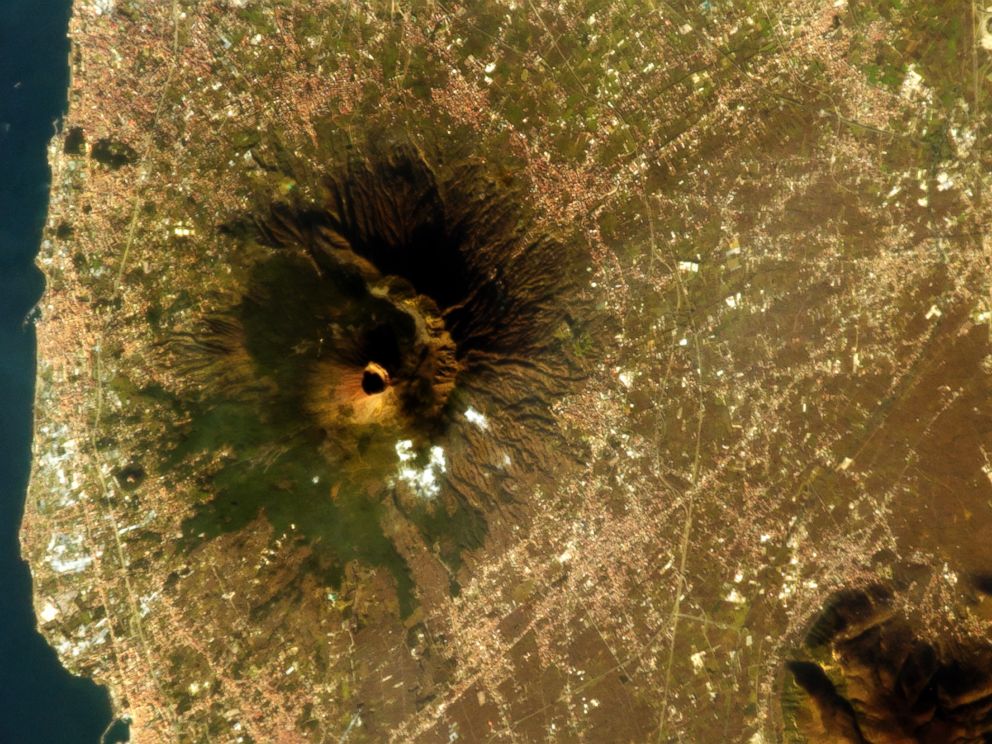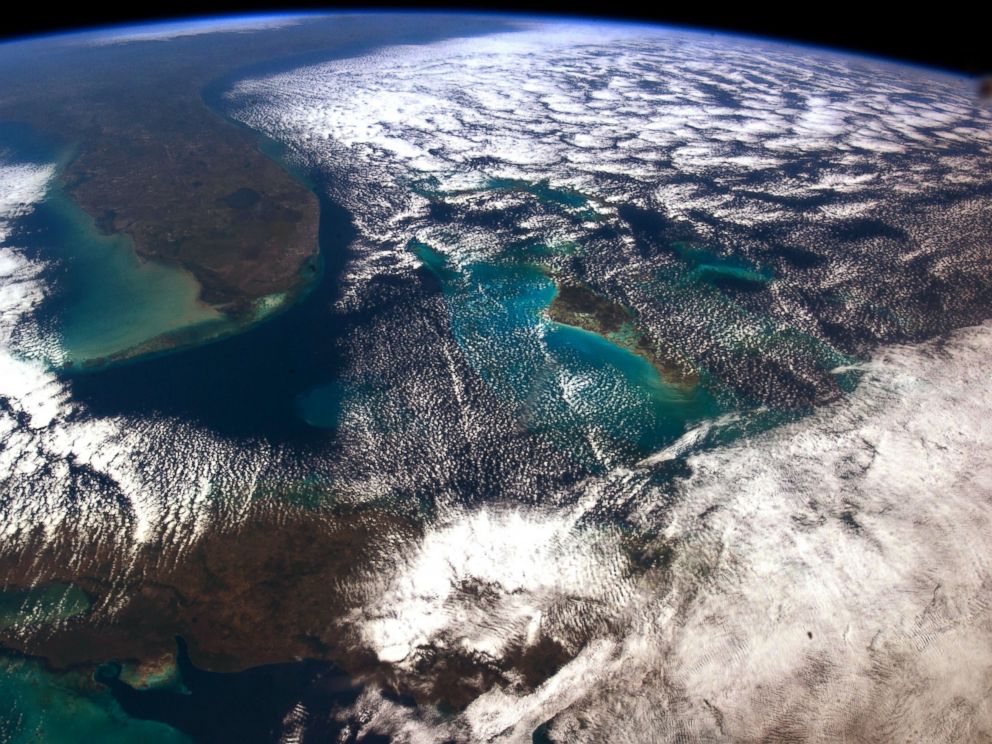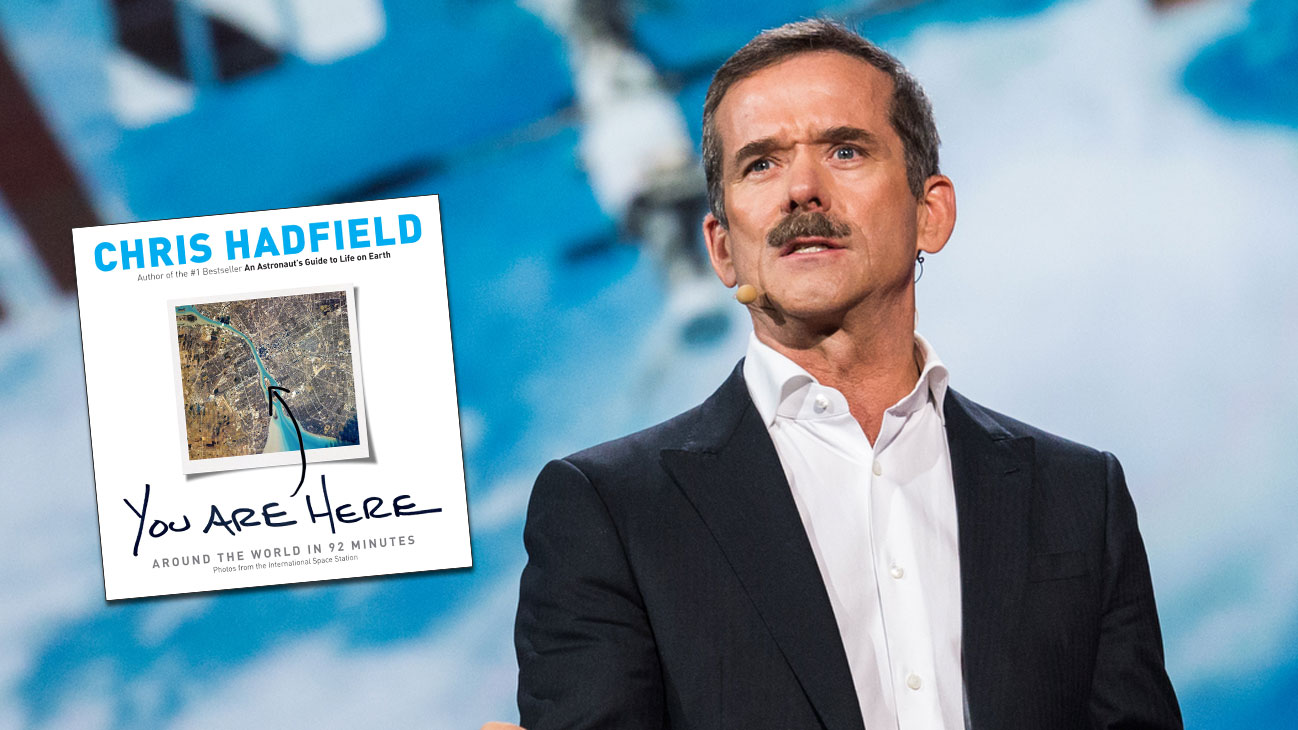Colonel Chris Hadfield has become a worldwide sensation, harnessing the power of social media to make outer space accessible to millions and infusing a sense of wonder into our collective consciousness not felt since humanity first walked on the Moon. Last year, Chris released his bestselling memoir, An Astronaut’s Guide to Life on Earth, and today, his new book, You Are Here: Around the World in 92 Minutes, hits store shelves everywhere. A collection of his favorite, never-before-seen images, all taken from the International Space Station, the book helps us all see the big picture: why our planet looks the way it does and why we live where we do. Drawing on his in-depth knowledge of geology, geography, and meteorology, Chris takes us on a planetary photo tour and explains the mysteries these stunning images reveal. Biography.com sat down with Chris talk about the new book, as well as the lessons he’s learned from living in space:
Colonel Chris Hadfield, the first Canadian astronaut to walk in space, is a seriously impressive guy who has racked up some superhuman accomplishments on Earth and in space, but if you read his bio on his official website, he owes a lot of that to his moustache. Sure he became an astronaut against the odds at a time when his country didn’t have a space program. Yes, he went on to command the International Space Station and become a YouTube sensation with his zero gravity version of David Bowie’s “Space Oddity.” And he’s orbited the world only about 2,600 times. But having that moustache, he writes, “is a big responsibility” and he had to earn the right to wear it. That says a lot about the man: he’s got a sense of humor, and he’s not afraid to use it.
That sense of humor along with his mind-blowing social posts that will make you rethink your place in the universe have earned Hadfield millions of fans and followers. Now retired, he’s on a new mission on Earth: to share his space travel experiences with his fellow humans. He’s already written an international bestseller, An Astronaut’s Guide to Life on Earth, and his new book, You Are Here, Around the World in 92 Minutes – a must-see and read for anyone who’s ever wondered what it’s like to be Hadfield.
We caught up with Hadfield as he prepared to release his new book and perform with the Windsor Symphony a suite of music he wrote on the Space Station. (Impressive again…must be the moustache.) Here are his thoughts on space, life, social media, and some lessons for us earthlings. (Plus, he puts the “Star Wars or Star Trek” debate to bed!)
Sci-Fi is The Stuff That Dreams & Reality Are Made On
I was inspired by science fiction. I read Edgar Rice Burroughs, Arthur C. Clarke, Jules Verne, H.G. Wells and all of those fanciful, imaginary heroes. Movies and TV like Star Trek also inspired me – I thought James Tiberius Kirk was the coolest guy ever, and I loved 2001: A Space Odyssey. But what was key was at the same time that was happening in reality for the very first time with John Glenn, Al Shepard, Yuri Gagarin, Alexey Leonov. We were leaving Earth for the first time, and it all really came to a head – the combination of fantasy and reality when Neil Armstrong and Buzz Aldrin walked on the moon. That was a really watershed day for a lot of people especially for this little nine-year-old because watching Neil and Buzz walk on the moon on July 20, 1969 was the day I decided I was going to be an astronaut.
To become an astronaut, it takes a deep love of the idea. A great passion – like anything that is going to take a lot of work and focus, it needs to be in your heart of hearts. You have to be like Picasso about painting. You have to be like Einstein about concepts, or like any of the great passionate inventors, and have that feeling that this is what I want to do in life because getting to be an astronaut is extremely difficult and unlikely. After passion, it takes skills – knowing how to fly, how to scuba dive, how to speak other languages, how to operate a complex machine, how to make good decisions when the consequences really matter. It also takes a healthy body that you’ve taken care of, an advanced complicated education because we need people that can learn things at a high level at a high speed.
Space Tourism: The Next Frontier?
We are just on the cusp of space tourism. There have been a few very wealthy people who have been able to travel on the Russian spaceship, the Soyuz. [Think of] when you get on an airline and the flight attendants give that briefing about where the exits, strip lighting and oxygen masks are, it takes about a minute. To fly in the Soyuz, that briefing takes about nine months just so that you can be a safe passenger onboard. Richard Branson is trying to make it more readily available, not orbital, not going all around the world, but going straight up and straight back down again, and that hopefully will cost much less than what it costs our tourists that have gone so far. It’s still very expensive – the price of an extreme luxury car to go for a quick space flight. But there are lots of people buying lots of luxury cars so maybe there is a market there. It’s like aviation in 1915 – was the sky ready for tourism? Not really, but it was just in its infancy. Now, of course, where would tourism be without aviation? Eventually we’ll get there.
If You Did Go to Space, What’s for Dinner?
Eating in space is like being on a camping trip forever, where there is no microwave and no oven so all of your food has to be something you can carry in a backpack and you can eat without a plate. It’s a lot of dry food that you add water to and eat out of a pouch, a pouch of tuna, or a granola bar. It’s food that will sit on the shelf for months and won’t go bad. It would be like if you ate entirely out of your pantry and never used a plate because, of course, plates don’t help when there’s no gravity. And you don’t eat your food mixed together because you don’t have a plate – so broccoli and meat and potatoes and corn – you typically open each pouch separately and eat them sequentially. So the food is not delightful, but it’s fine and healthy and I came back to Earth in good shape.
And There’s Entertainment, Too. . .
There are a lot of astronauts who are musicians. There’s a guitar in the Space Station and it gets played every day. If you look at the tablature of music and think of how the circle of fifths work and the chording and the tempos, it’s sort of like a form of math – a lot of music is very analytical and complex. And when you’re playing in a group, as I do as often as I can, there is a shared, unspoken, complex language. There is something between intuition and skill going on and so there are a lot of astronauts who, by nature, are musicians. It’s not vital – there are some astronauts who are not musical at all – but I think we’re above the national average in that there is always music on the Space Station.
Space Tip: If You Ever Meet an Alien, Play The Beatles
On my first space flight when I helped build the Russian space station Mir, I brought a guitar and gave it to the Mir crew as a gift. They had an old Russian acoustic guitar up there as well. I asked: ‘Is there a song that astronauts play together?’ And I discovered if that circumstance arises, you should play The Beatles because everybody knows The Beatles. So we played several Beatles tunes. I think as opposed to what happened in Close Encounters of the Third Kind, if we do run into aliens and there is a quiet moment, we should just play Beatles and everybody will figure it all out (laughs).
Liking Space (Via Social Media)
To me, social media is along the lines of [the] Gutenberg [Bible] or the telephone because it’s revolutionizing how we communicate with each other. It opens up a two-way conversation with everybody in the world. The Canadian Space Agency and my son Evan have worked really hard with me to broadcast on social media. I could see something unique or different in space like I would open a can of peanuts and see that they looked like flying larvae. It was so visually shocking that I did a quick video of it, sent it to the ground and had it put on YouTube and suddenly millions of people shared that experience. Or I could take a picture of an island off of Greece that looked like the shape of a heart. How beautiful is that? And then I would send it to the world via Twitter and my son Evan would take that Twitter feed and put it on other social media outlets. And just by opening up that method of communication, it was contagious and by the time I landed, I had a million people on a day-to-day basis sharing information, too.
Seeing Ourselves in the Universe
Evan at one point said to me: ‘Hey, Dad, why don’t you ask people what they want you to take a picture of?’ And so I did. And three quarters of a million people said, ‘I want you to take a picture of my hometown.’ I realized that people are proud of where they’re from and they want to see what their hometown looks like in the world. And that was really revealing to me that what people wanted is a more clear understanding of self and where they fit in. And so I posted lots of pictures of towns I never even heard of, and then tens of thousands of people responded and sent notes back and said ‘Thank You’ or ‘That’s where my child was born,’ and that sense of sharedness is a wonderful result of social media. Social media and the work that Evan did were an enormous part of people better understanding what we’re doing in space.
What We Can All Learn from Seeing the World in 100 Orbits
I would love the opportunity to take everybody on 100 orbits of the world with me. To sit by the window of the Space Station, to float weightless just holding on by your fingertips at the big bulging cupola window and just take the time to watch the world. It is immensely, startlingly beautiful. Each time you come around the world, the world has changed – the weather patterns have changed, the seasons have changed, the angle between you and the sun and the Earth changes and you develop an increasing understanding and awareness of the world like watching something grow and flower. And, inevitably, somewhere along the way you start to lose your sense of foreignness of ‘us’ and ‘them.’ You lose that sense that the little square that you walk around in is the only one that matters. The more people who could see the immensity of it, the beauty of it, the patience of it, the age of it, the toughness of the world and the precious, unique beauty of it – it’s a Christmas ornament of a thing in the endless blackness of space – the better we would all be.
Bonus: Rapid-Fire Round!
Star Trek or Star Wars? Star Trek
2001: A Space Odyssey or Close Encounters of the Third Kind? 2001
Alf or E.T.? E.T.
The Jetsons or Lost In Space? Jetsons
WALL-E or Avatar? Avatar
X-Files or Twilight Zone? Twilight Zone
Battlestar Galactica or Dr. Who? Galactica, the new one for sure.
H.G. Wells or Ray Bradbury? That’s hard – I have to go with both.
Arthur C. Clarke or Isaac Asimov? I cannot choose.
One person you want to duet with? Emmylou Harris.
Poutine or Maple Syrup? Maple syrup
Canada or Canada? Canada! You got it and the Maple Leafs for sure.

Chris Hadfield took this photo of Mount Vesuvius in Italy from the International Space Station.
Chris Hadfield took this photo of Cuba and Florida from the International Space Station.
Chris Hadfield took this photo of Cuba and Florida from the International Space Station.
By Leanne French/Biography.com/October, 2014

